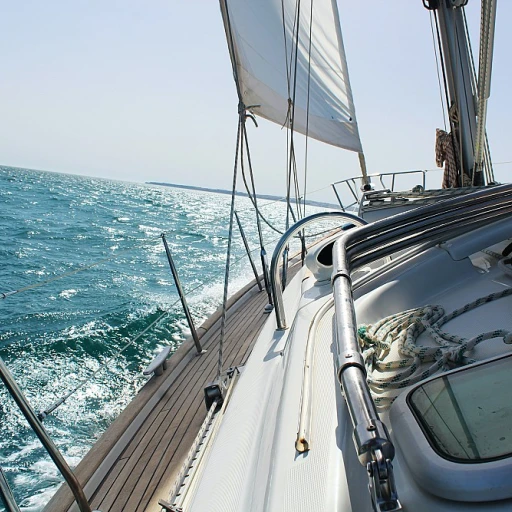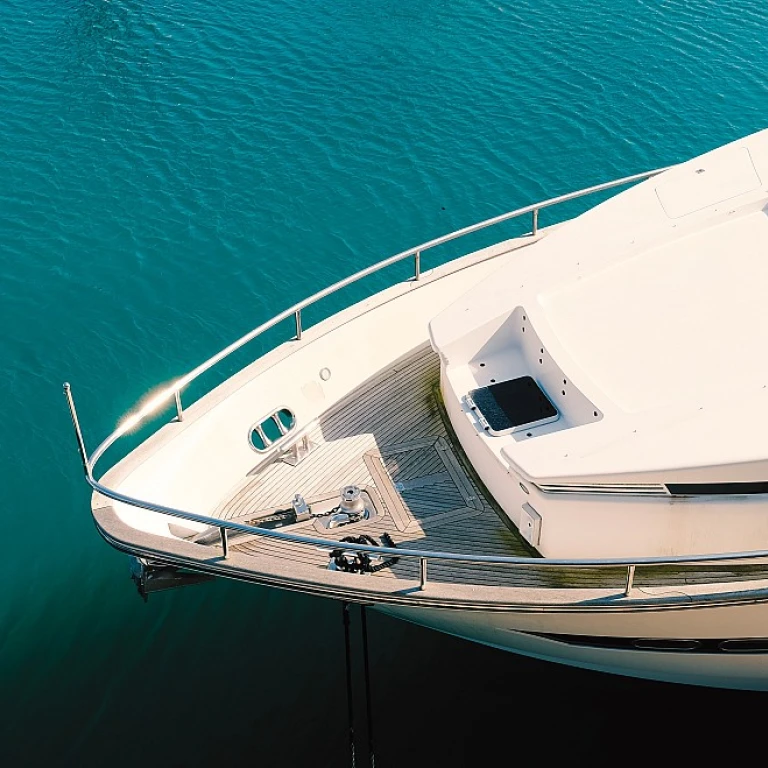Understanding Anchor Chain Specifications
Deciphering the Language of Anchor Chains
Choosing the right anchor chain size for a 44 lb anchor is crucial to ensure the safety and stability of your boat while anchoring. Understanding anchor chain specifications can be daunting, but breaking it down into manageable components eases this task.
Each anchor chain is characterized by its grade, material, and dimensions. The chain's size is typically described in terms of its diameter, commonly measured in millimeters or inches. When considering an anchor for a 44 lbs boat anchor, it's vital to check the chain's breaking strength and its ability to withstand the forces exerted by the boat's weight and environmental conditions.
The chain's grade pertains to its tensile strength. Higher-grade chains provide more holding power, important for keeping the boat moored securely. A good rule of thumb is to match the chain's breaking strength to the anchor's weight. The grade chain used will directly affect the chain rode effectiveness, particularly in challenging conditions.
Materials play a critical role, too. Galvanized chains are often chosen for their excellent corrosion resistance. However, in certain cases, a stainless steel chain may be preferred for its aesthetic appeal and enhanced durability. Deciding between these options is critical in selecting an anchor chain that complements both the anchor size and the anchoring strategy.
Alongside these specifications, understanding how these elements fit into the overall anchor rode configuration, including the chain length and anchor rope integration, forms the foundation of safe and effective anchoring on any body of water. For those considering advanced anchoring setups, exploring the capabilities of a
15 hp outboard motor could offer additional insights into optimizing your boat's anchoring performance.
Factors Influencing Chain Size Selection
Key Considerations for Selecting Anchor Chain Size
Choosing the right anchor chain size is crucial for every boat owner. Several factors come into play when selecting the optimal chain size for a 44 lbs anchor. These factors not only affect the performance but also the safety of your boat.
- Boat Length and Weight: The anchor chain size largely depends on your boat's length and weight. The longer and heavier the boat, the stronger the chain needed. Generally speaking, the larger the boat, the thicker the chain size you will require to ensure sufficient holding power.
- Anchor Type: The type of anchor, such as a Rocna or any other style, impacts the chain size. Some anchors have higher holding power and may require less chain.
- Scope and Rode: It's important to consider the scope, which is the ratio of chain length to the water depth. A longer chain with a proper scope increases holding power by keeping the anchor at the right angle. Typically, a scope of 7:1 is recommended, meaning for every foot of water depth, there should be seven feet of chain.
- Chain Grade: The strength of the chain is denoted by its grade, with higher grades offering greater tensile strength. Higher grade chains allow for a smaller diameter chain with comparable strength, which can be advantageous for weight considerations on the bow and windlass capacity.
- Rode Combination: Often, a combination of chain and rope (nylon rode) is used. A section of chain combined with a longer length of nylon rope can effectively handle anchor loads and expand the anchor rode for more flexibility.
Selecting the right anchor chain requires understanding these factors while considering the overall anchoring strategy. For further insights into the role specific equipment plays aboard, explore the importance of
TDS water makers in yachting to enhance long-term sailing experiences.
Comparing Chain Materials: Galvanized vs. Stainless Steel
Deciding Between Galvanized and Stainless Steel Chains
When selecting an anchor chain, the choice between galvanized and stainless steel is critical and directly impacts the overall durability of your anchoring system. Here are the considerations you should keep in mind:
- Galvanized Chains: These are typically favored for their cost-effectiveness and strong resistance to rust and corrosion. The zinc coating on galvanized chains offers a substantial protective layer, making them a popular choice for many boat owners. They're particularly suitable for vessels that frequently anchor in saltwater environments, thanks to their impressive holding power. However, over time, the zinc coating can wear down, necessitating regular maintenance checks and potential recoating.
- Stainless Steel Chains: While more expensive, stainless steel chains provide unmatched corrosion resistance and aesthetic appeal. Their polished finish not only looks good but contributes to lower maintenance requirements as well. For yachts in need of optimal performance in both fresh and saltwater, stainless steel can be an excellent investment. It's important to remember, though, that the steel’s grade can dictate how well it will perform, so make sure to review the specifications carefully before making your decision.
Both options have their merits, but the ultimate choice will depend on your boating conditions, willingness to perform maintenance, and budget capacity. To dive deeper into the essentials of ensuring your yacht is equipped with the right materials, you might consider exploring the
replacement parts required for different yacht systems, as maintaining various components is key to a successful voyage.
Calculating the Optimal Chain Length
Determining the Appropriate Chain Length for Your Boat
Calculating the optimal length of an anchor chain is a crucial aspect of ensuring safe anchoring. The chain length, often measured in feet, needs to correspond with the size of your boat and the weight of your anchor to provide effective holding power.
To start, consider your boat's length and the anchor's weight in determining the appropriate length of the anchor chain. A common rule of thumb suggests using a chain length that is at least five times the depth of the water where you plan to anchor. This ratio, known as the scope, helps in maintaining sufficient tension in the chain to keep the anchor secure on the seabed. For instance, if you plan to anchor in a depth of 20 feet, then a 100-feet chain will be necessary under normal conditions.
When calculating the correct chain length, it’s also important to consider the windlass capacity and the overall anchor rode setup, which might include a combination of chain and nylon rode. The chain should ideally be long enough to provide weight at the bow of the boat, increasing the anchor's holding power. Additionally, incorporating a nylon anchor rope within your setup can add elasticity, which acts as a shock absorber during waves or gusts of wind, enhancing the anchoring capability.
It's essential to regularly check and expand your knowledge on anchor chain specifications to ensure your equipment adequately matches your boating needs and conditions. Always consider the weight and size of your anchor when selecting the anchor chain length, as using an undersized chain may compromise safety. Conversely, an excessively heavy chain could unnecessarily burden your boat, affecting performance.
Ultimately, by accurately calculating the optimal anchor chain length, using the appropriate chain size, and regularly reviewing the conditions and setup of your anchoring system, you'll maintain both safety and performance every time you set anchor.
Maintenance Tips for Anchor Chains
{
\"result\": \"
Effective Care for Anchor Chains
\n\nMaintaining your anchor chain is crucial to ensure it continues to provide reliable performance on your boat. Here's a look at some key maintenance tips for keeping your anchor chain in top condition.\n\n
\n - Regular Inspection: It's vital to frequently check your chain for signs of wear and tear. Look for rust, and any structural damage, particularly around the links where stress and friction might occur. This regular check helps in detecting issues early before they compromise the chain's holding power.\n
\n - Cleaning: After each use, especially in saltwater, make sure to rinse the chain with fresh water. Salt can corrode both galvanized and stainless steel chains, so removing it promptly helps extend the life of your chain.\n
\n - Lubrication: Occasionally applying a light coat of lubricant to the chain can reduce friction between links and protect against rust. Pick a lubricant suitable for marine environments to ensure optimal protection.\n
\n - Correct Storage: Storing the anchor chain properly is crucial. Ensure it is stored away from any harsh chemicals or sharp objects that could damage it. Also, coil the chain neatly to prevent kinks and tangling, which can weaken the chain over time.\n
\n - Windlass Maintenance: For those using a windlass, check its compatibility with your chain size and weight frequently. Proper maintenance of the windlass itself ensures it doesn't put extra strain on the chain, enhancing both safety and longevity.\n
\n - Anchor Retrival: When retrieving your anchor, avoid jerky motions. This practice helps maintain the structural integrity of both the chain and nylon rode, reducing the risk of damage.\n
\n
\n\nProper maintenance of your anchor chain not only extends its lifespan but also ensures that it maintains the critical connection to your anchor, optimally securing your boat against wind and tide.\n"}
}
Common Mistakes to Avoid When Choosing an Anchor Chain
Common Pitfalls in Selecting the Correct Anchor Chain
Choosing the right anchor chain for your boat is a critical task, but several mistakes can arise if you aren't well-prepared. A frequent oversight is mismatching the chain size with the anchor weight. Ensure the chain you select is capable of bearing the anchor's weight, whether it's a Rocna or other type. Equally important is checking that the chain's grade aligns with your anchoring needs for enhanced holding power.
Another pitfall to watch out for is neglecting to measure the boat length and the required chain length effectively. The ideal chain length should account for the depth at anchoring spots, adjust for changes in tide, and expand when needed. Proper calculations will give confidence in a good scope, ensuring stability and security.
Moreover, while the allure of stainless steel chain often attracts yacht enthusiasts due to its appearance and durability, consider if galvanized options could offer sufficient rust resistance for your needs combined with cost efficiency. Use the chain materials comparison from earlier sections as a guideline here.
Not considering the interplay between anchor rope and chain size can lead to complications with the anchor rode system. Striking a balance between the chain and nylon rode, factoring in drag and rope elasticity, is crucial to maintaining tension and performance.
Finally, installing an adequate windlass for your chosen chain size and weight is necessary. An insufficient windlass might lead to mechanical faults and operational inefficiencies. Regularly check and maintain your setup, keeping spare parts handy. Avoid these missteps to ensure peace of mind and enjoy smooth sailing adventures on the open waters.

